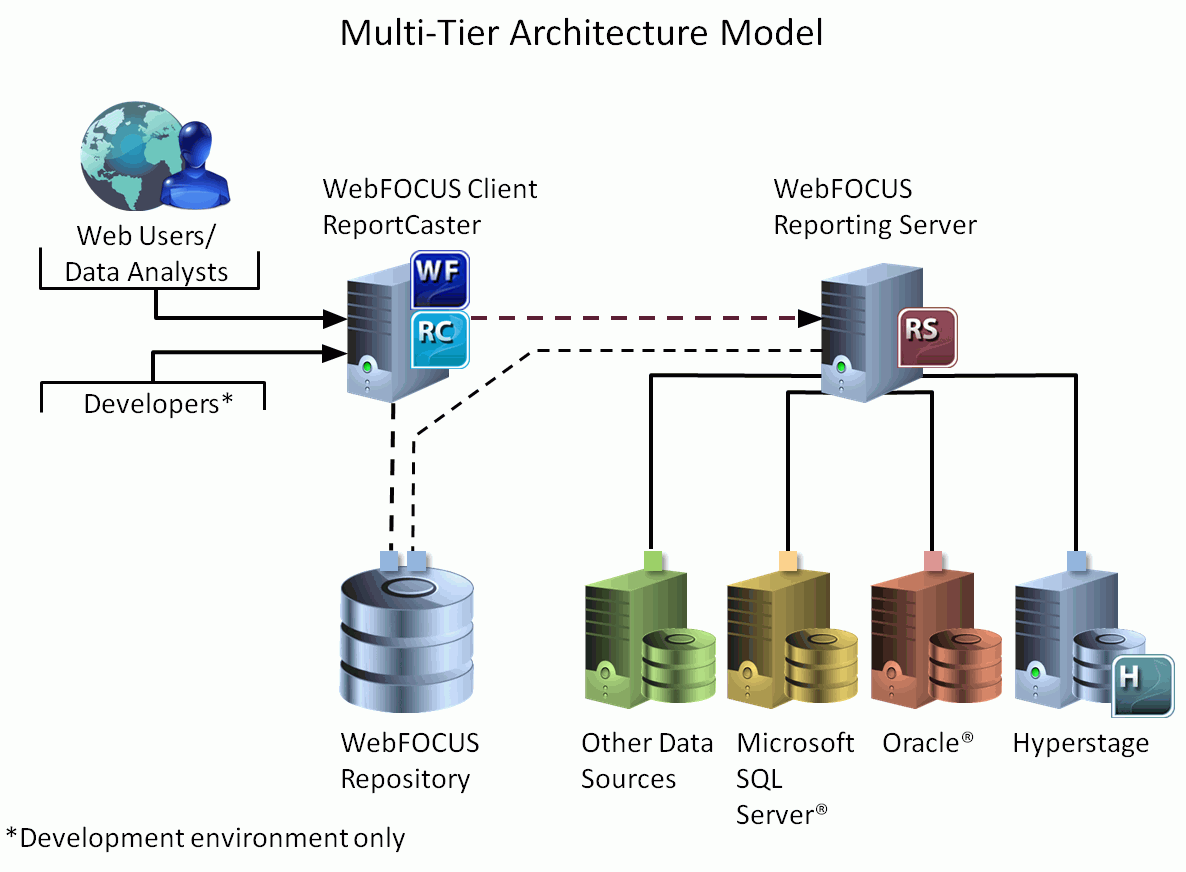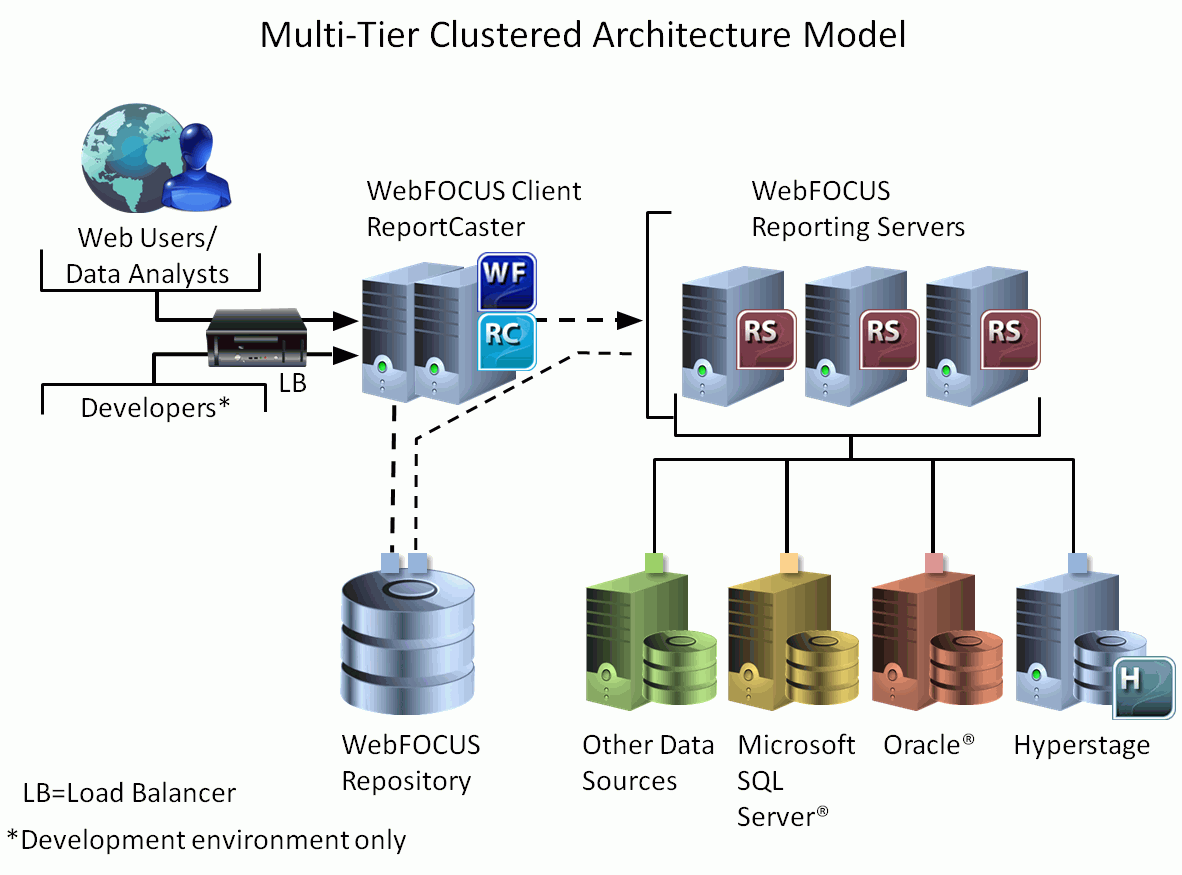WebFOCUS Architecture Models
The WebFOCUS layers can be leveraged to create several
architecture models, as explained in the following sections. In
all architecture models, to minimize network traffic and reduce
network latency it is recommended that:
- Data sources be located as close as possible to the WebFOCUS
Reporting Servers.
- WebFOCUS database repositories be located as close as possible
to the WebFOCUS Client.
xSingle-Tier Architecture Model
In a single-tier architecture model, the Presentation
and Reporting and Metadata Layers are hosted on a single machine,
as shown in the following image. The Data Layer should be on machines
separate from the other layers.

The single-tier architecture model:
- Does not support high availability, failover, or load management
at the Presentation and Reporting and Metadata Layers.
- Restricts users from accessing the WebFOCUS application if either
the Presentation or Reporting and Metadata Layers are taken down
for maintenance or for other reasons.
Note: Sufficient system resources are required to handle
the projected workload and meet Service Level Agreements (SLAs),
if they are in effect.
It is understood that sometimes there are constraints around
procuring hardware that makes it difficult to keep the layers separate.
It is for that reason that we have covered the single-tier architecture
model as an option, although it is not a best practice.
xSingle-Tier Clustered Architecture Model
In a single-tier clustered architecture model, Presentation
and Reporting and Metadata Layers are hosted on the same machine,
but replicated on additional machines using a cluster mechanism,
as shown in the following image. Clustered components are referred
to as cluster members. To a user, it appears that there is a single Presentation
Layer. The Data Layer should be on machines separate from the other layers.

The single-tier clustered architecture
model supports high availability and failover at the Presentation
and Reporting and Metadata Layers. Users will still be able to access
the WebFOCUS applications if cluster members of the different layers
are taken down for maintenance or other reasons.
Note:
- To support high availability, the WebFOCUS
Repository, the databases, and the shared file systems must also
support high availability.
- Sufficient system resources are required to handle the projected
workload and meet Service Level Agreements (SLAs), if they are in
effect.
xMulti-Tier Architecture Model
In a multi-tier architecture model, Presentation and
Reporting and Metadata Layers are installed on separate machines,
as shown in the following image. The Data Layer should be on machines
separate from the other layers.

The multi-tier architecture model:
- Keeps the Reporting and Metadata
Layer separate from the Presentation Layer, making it easier to
isolate either layer.
- Allows for clear separation of responsibilities for the different
layers.
- Conforms to security regulatory policies by keeping each layer
separate.
- Supports high availability and failover at the Presentation
and Reporting and Metadata Layers. Users will still be able to access
the WebFOCUS applications if cluster members of the different layers
are taken down for maintenance or other reasons.
Note: Sufficient system resources are required to handle
the projected workload and meet Service Level Agreements (SLAs),
if they are in effect.
xMulti-Tier Clustered Architecture Model
In a multi-tier clustered architecture model, Presentation
and Reporting and Metadata Layers are installed on separate machines,
but replicated across additional machines using a cluster mechanism,
as shown in the following image. Clustered components are referred
to as cluster members. To a user, it appears that there is a single Presentation
Layer. The Data Layer should be on machines separate from the other
layers.

The multi-tier clustered architecture model:
- Keeps the Reporting and Metadata Layer separate from the
Presentation Layer, making it easier to isolate either layer.
- Allows for clear separation of responsibilities for the different
layers.
- Conforms to security regulatory policies by keeping each layer
separate.
- Supports high availability and failover at the Presentation
and Reporting and Metadata Layers. Users will still be able to access
the WebFOCUS applications if cluster members of the different layers
are taken down for maintenance or other reasons.
Note:
- To support high availability, the WebFOCUS
Repository, the databases, and the shared file systems must also
support high availability.
- Sufficient system resources are required to handle the projected
workload and meet Service Level Agreements (SLAs), if they are in
effect.



